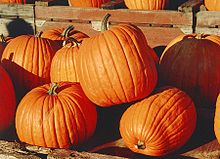This is an old revision of this page, as edited by Hkit (talk | contribs) at 17:51, 26 August 2006 (→Pumpkin trivia). The present address (URL) is a permanent link to this revision, which may differ significantly from the current revision.
Revision as of 17:51, 26 August 2006 by Hkit (talk | contribs) (→Pumpkin trivia)(diff) ← Previous revision | Latest revision (diff) | Newer revision → (diff)- For the film, see Pumpkin (film).


A pumpkin is a squash fruit, most commonly orange in colour when ripe. Pumpkins grow as a gourd from a trailing vine of the genus Cucurbita Cucurbitaceae. Cultivated in North America, continental Europe, and some other countries, as well as in English cottage gardens, Cucurbita varieties include Curcurbita pepo, Cucurbita maxima, Cucurbita mixta, or Cucurbita moschata — all plants native to the Western hemisphere. The pumpkin varies greatly in form, being sometimes nearly globular, but more generally oblong or ovoid in shape. The rind is smooth and variable in colour. The larger kinds acquire a weight of 40 to 80 lb (18 to 36 kg) but smaller varieties are in vogue for garden culture. Pumpkins are a popular food, with their innards commonly eaten cooked and served in dishes such as pumpkin pie. Pumpkins are traditionally used to carve Jack-o'-lanterns for use as part of Halloween celebrations.
Botanically it is a fruit, referring to a certain plant part which grows from a flower. However it is widely regarded as a vegetable in culinary terms, referring to how it is eaten.
Butternut squash is called "butternut pumpkin" in Australia, where it is commonly regarded as a pumpkin and used in similar ways to other pumpkin.
Cultivation
Pumpkins have historically been pollinated by the native squash bee Peponapis pruinosa, but this bee has declined, probably due to pesticide sensitivity, and most commercial plantings are pollinated by honeybees today. One hive per acre (4,000 m² per hive) is recommended by the US Department of Agriculture. Gardeners with a shortage of bees, however, often have to hand pollinate.

Inadequately pollinated pumpkins usually start growing but abort before full development. Often there is an opportunistic fungus that the gardener blames for the abortion, but the solution to this problem of abortion tends to be better pollination rather than fungicide.
Pumpkins are grown today in the US more for decoration than for food, and popular contests continually lead growers to vie for the world record for the largest pumpkin ever grown. Growers have many techniques, often secretive, including hand pollination, removal from the vines of all but one pumpkin, and injection of fertilizer or even milk directly into the vines with a hypodermic needle.
Chunking
Pumpkin chunking is a competitive activity in which teams build various mechanical devices designed to throw a pumpkin as far as possible. Catapults, trebuchets, ballistas and air cannons are the most common mechanisms. Some pumpkin chunkers grow special varieties of pumpkin, which are bred and grown under special conditions intended to improve the pumpkin's chances of surviving being thrown.
Pumpkin seeds
The hulless or semi-hulless seeds of pumpkins can be roasted and eaten as a snack, similar to the sunflower seed. They are a good source of essential fatty acids, potassium, and magnesium. In Latin America these are often greenish in color and known as pepitas. One of the typical pumpkin products of Austria is pumpkin seed oil.
Cooking
When ripe, the pumpkin can be boiled, baked and roasted, or made into various kinds of pie, alone or mixed with other fruit; while small and green it may be eaten in the same way as the vegetable marrow.
Pumpkin trivia

- The pumpkin is related to the zucchini.
- Pumpkin growers often compete to see whose pumpkins are the most massive. Festivals dedicated to the pumpkin and these competitions are relatively widespread and some form tourist attractions in their own right, for example in Half Moon Bay, California.
- The largest pumpkin ever grown weighed 1,469 lb (666 kg). Raised by Larry Checkon from Northern Cambria, Pennsylvania in 2005, it is technically a "squash," Cucurbita maxima, and was of the public variety "Atlantic Giant," which is the "giant" variety - culminated from the simple hubbard squash by enthusiast farmers through intermittent effort since the mid 1800's.
- Pumpkins are orange because they contain massive amounts of lutein, alpha- and beta-carotene. These nutrients turn to vitamin A in the body.
- Using pumpkins as lanterns at Halloween is based on an ancient Celtic custom brought to America by Irish immigrants. All Hallows Eve on 31 October marked the end of the old Celtic calendar year, and on that night hollowed-out turnips, beets and rutabagas with a candle inside were placed on windowsills and porches to welcome home spirits of deceased ancestors and ward off evil spirits and a restless soul called "Stingy Jack," hence the name "Jack-o'-lantern".
- The city of Keene, New Hampshire currently holds the world record for the most lit pumpkins in one location: 28,952
- Illinois produces more pumpkins than any other state in the United States; Michigan is a distant second.
- Pumpkins were among the first foods from the "New World" adopted in Europe, probably due to a European cousin: Lagenaria
- "Pumpkin" is sometimes used as an affectionate term, often referring to one's significant other. For example: "I love you, Pumpkin."
- The pumpkin is the state fruit of New Hampshire.
See also
References
- Illinois Leads Nation in Pumpkin Production, Illinois Department of Agriculture.
- The Largest Pumpkin Ever, bigpumpkins.com.
- Keene Pumpkin Festival, list of world records.
External links
- The Circleville Pumpkin Show
- Keene Pumpkin Festival
- Halloween Pumpkin Carving Ideas
- Extreme Pumpkin Carving
Information on pumpkin varieties
- Pumpkin Varieties - backyardgardener.com, site focused on North-Eastern USA.
- April 2004 – In season describes several varieties available in Australia.
- Pumpkins - Lots and lots of Varieties! - American pumpkin varieties, arranged by species.
- Squashes and Pumpkins - Oregon State University. Arranged by species.